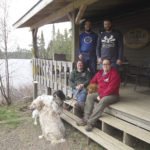Faced with the unusual circumstances brought about by the Covid-19 pandemic, museums and galleries along the North Shore are finding new ways to share their message. Concerned for the safety of visitors, volunteers and staff, they are unsure how and when they will open their doors to the public.
“What we’re trying to express to people is things are not going to look the same this summer,” said Anna Deschampe, chief of interpretation at Grand Portage National Monument.
While the national monument is open, the buildings—the Heritage Center and Depot—are closed. Located with the Grand Portage Reservation, the monument is working with the local community to address health and safety concerns. The Grand Portage National Monument will have a phased reopening of services guided by the best available science, public health guidelines, and community characteristics. When the monument reopens social distancing will be implemented to protect staff and visitors. The use of face coverings will be strongly recommended. In the meantime, the monument has stepped up its online presence on Facebook. You can take a virtual tour of the museum and get updated information at the monument’s website: nps.gov/grpo.
Up the Gunflint Trail at Chik-Wauk Museum and Nature Center, visitors can park at the gate and walk the trails on the grounds. Weekly, virtual nature walks are available via YouTube. Chik-Wauk’s tentative reopening is scheduled for July 10, dependent on state health advisories.
“When we open, the number of people allowed inside will be limited,” said Suzanne Weber, president of the Gunflint Trail Historical Society, which operates the facility. “It will be strongly suggested that they wear a mask.”
Like many museums, Chik-Wauk contains displays that are meant to be touched, which creates a concern for cleaning and hygiene. Weber said the museum is following cleaning recommendations in the handbook developed for local businesses, but says the handbook doesn’t address fur and feathers. They are looking for guidance from other museums on cleaning the furred and feathered displays in the nature center.
At the Tweed Museum of Art on the University of Minnesota, Duluth campus, director Anja Chávez says she is in touch with other museums in Minnesota and beyond to compare notes about how to safely reopen and keep abreast of new information.
“This is the first time we find ourselves in a true international community,” she said. “It’s good that we work together on impactful solutions to welcome back our communities. As museum professionals, we long to be there for our communities and we are seeking creative solutions to make this happen.”
She said that one of the first museums to reopen is located in Germany. Although there remains a need to control the number of visitors and ensure social distancing occurs, that facility is trying to do so in a playful manner.
While she is uncertain when the Tweed will reopen, there is already much preparation work going. Chávez says the staff is busy caring for collections, addressing space flow issues, renovating the facilities, conducting research, releasing teasers, and getting the Tweed situated virtually. A renovation project to remove carpet from the second floor and to reconsider use of the space is ongoing. Two UMD professors are collaborating with Tweed staff on a project to document the pandemic’s effect on local communities, with the working title “Stories of Wisdom Accentuated by Stress.”
“These are unusual times for all of us, and this includes the Tweed,” she said. “When we reopen, the experience will be different, as well as welcoming and exciting. We are definitely looking forward to reconnecting with our communities in person”
For Carrie Johnson, director of the Cook County Historical Society, having the staff to reopen three sites, the Cook County Museum, Johnson Heritage Post and Chippewa City Church is her biggest concern.
“We are operated by elderly volunteers,” Johnson said. “We’ve already decided we won’t be using them this year.”
Johnson has put out a call asking other, younger community members to step forward, but doesn’t know if enough will be available to operate three sites. If staffing is limited, the historical society will focus on one site, possibly the Johnson Heritage Post. Even though the facilities are closed, the historical society still responds to people’s research requests. They are working behind the scenes to preserve collections and maintain historic sites. They are moving forward with a building plan to house the society’s archives, but are unable to launch a capital campaign for donations while the economy is slowed. Johnson said they are working on virtual exhibits for their website, cookcountyhistory.org. The current focus is a maritime exhibit on steamships that will be sent to schools and will include a public television documentary about the steamer America.
The Thunder Bay Art Gallery hasn’t set a reopening date, because it is dependent on provincial guidance. At this writing, Ontario’s state of emergency extends to June 2.
“We’ll hit the ground running whenever we can,” director Sharon Godwin wrote in an email.
The gallery is active on its website, theag.ca with the Be Kind Project for kids. and is continuing outreach work with partner organizations. They provide participatory “zines” as part of the Roots to Harvest food deliveries to seniors and youth and deliver hands-on textile projects to other partner agencies who serve people overcoming addiction.
There may be growing pains, but museums and galleries will adapt to the new realities of social distancing and hygiene. Godwin observed they are better poised to do so than some other institutions. “…galleries will probably have a much easier time welcoming the public (with social distancing) than live theatre, symphonies, etc,” she wrote. “It will be difficult for everyone, but a lot harder for them.”




